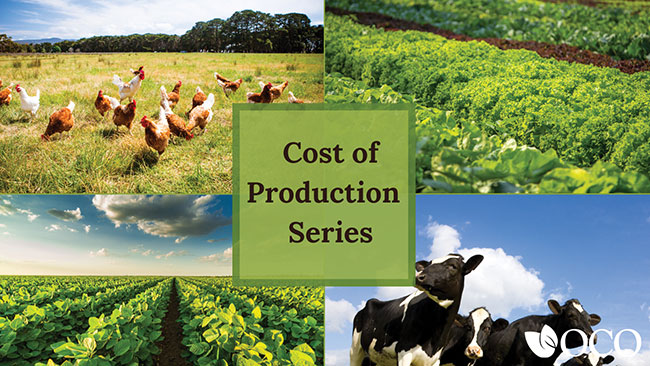
Features
Organic Perspective
Understanding costs of production
March 26, 2021 By Stuart Oke and David Cohlmeyer

For more than a year, the Organic Council of Ontario (OCO) has investigated the costs of production for certified organic producers in an attempt to better understand the different variables that affect organic production. Following extensive consultation with organic producers, involving thorough financial analysis and comparative benchmark development, OCO has now released a Cost of Production Series (COP), profiling a diverse range of organic products including:
- Organic salad greens;
- Organic field crops;
- Pastured organic poultry; and
- Organic dairy.
“There are more than 3.2 million acres in Certified Organic production in Canada, but surprisingly few resources to assist organic operators in assessing their profitability,” says Carolyn Young, OCO executive director.
This user-friendly series available through the OCO gives organic operators, transitioning operators and those considering switching to organic production a baseline from which to measure their own costs of production and farm product profitability. Each report contains thorough environmental scans, methodologies, analysis, and observations, as well as guides for readers to better learn how to make use of the data presented for their own benefit. A cost-of-production calculator is included for each crop type, allowing operators to input their own financial data and measure it against the studied benchmarks.
Below, we’ve provided a summary of one of the reports included in the series that was written by OCO board member, long-time organic producer and consultant, David Cohlmeyer.
The organic salad greens COP model allows a producer from a working market garden to use budget figures to determine their approximate full costs of production for organic salad greens. This can be used by either large- or small-scale growers, for seasonal outdoor production, with or without season-extension hoop-houses, and/or year-round greenhouse production that includes microgreens. It could also be modified to work for additional market garden vegetables. The results can serve as a valuable guide for business decision-making and understanding elements of profitability.
Analysis and observations from the organic salad greens COP model
With about five crops of salad greens per year, cash turnover of this enterprise can contribute to a healthy cash flow. Simply making a gross income claim for AgriInvest and SDRM government supports can have a tremendous effect on net profit. Equipment, seed, soil health and marketing investments (which may be eligible for a cost-shared grant through the Canadian Agricultural Partnership) can further benefit the farm’s overall resilience and profitability. Government-supported crop insurance for an inherently self-insured organic farm is generally not worth the premiums. Below is a summary of trends observed in the operations for this study.
Equipment, techniques and varieties
Generally, those with higher investments in equipment can expect lower labour costs. Tarping or multi-year cover crops are becoming popular, as these practices can reduce tedious weeding costs by 50 per cent. Transplanting newly developed “multi-leaf” lettuce varieties can reduce harvesting costs by 30 per cent. Higher greenhouse investments can significantly reduce energy costs as well.
Labour and marketing
It takes a lot of time each year to hire and train new workers, and switching from “free intern” labour to paying a premium wage for committed local or migrant workers can reduce total labour and management costs by 30 per cent. Higher pay rates for more effective and experienced workers typically resulted in lower labour costs as a percentage of total costs.
Plus, operations with increased marketing efforts can support at least 20 per cent higher prices by developing relationships and building a brand based on market research to learn customer value propositions.
Considerations when estimating your own costs
Like most other businesses, farms report their operating costs in a tax return or income statement at the end of the year with all costs assigned to general operating accounts. But important data is not captured by these tax filings. This data must be added to understand the costs of production and help with business decision-making. For example, few producers maintain a balance sheet, track specific labour activities, or record expenses by enterprise, each of which would assist in making farm decisions.
Considerations for new or transitioning operators
Becoming familiar with a market is an important first step for any new or transitioning operators. It can be challenging to begin selling to a restaurant or supplying retailers, but once established, these relationships generally remain for a long time.
Balanced soil fertility and active soil biology is needed for efficiently produced quality vegetable crops. An investment of time and money during the first few years for building soil health may be necessary.
You can find the full report, along with other COP models on organic field crops, dairy, and pastured poultry, on the OCO website at organiccouncil.ca.
The Organic Council of Ontario represents more than 1,400 certified organic operators, as well as the businesses, organizations, and individuals that bring food from farm to plate. OCO works to catalyze sector growth, support research, improve training, increase data collection, encourage market development, protect the integrity of organic claims, and inform the public of the benefits and requirements of organic agriculture.
Print this page